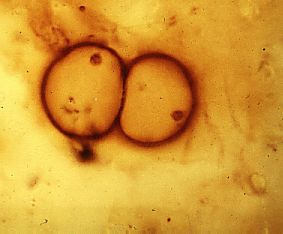Fossil Bacteria and Sites of Enriched Carbon-12
Perhaps most surprising is the ability of even tiny bacteria to form into
fossils. To the right is just such an example. These fossil bacteria
are about 850 m.y.o. The conditions must be just right for such a thing
to occur. Scientists must cut the rock in slices so thin that light
can pass through them, then study the slices with a microscope.
If these very early fossils were really photosynthetic, they were
really pretty advanced at an early, early time. More simple bacteria
existing even prior to this, > 3.5 b.y.a., can not be ruled out either.
The very oldest sedimentary rocks have been heavily processed,
destroying cell walls, etc. However, they retain their carbon
isotopic signature. Many of these very old sedimentary rocks show
a Carbon-12 enrichment, identical to that seen in biota
and in younger fossils. The very oldest rocks found, 3.8 b.y.o.,
show this carbon-12 enrichment, consistent with biological
activity. However, it can be argued that non-biological
activity can create the same fractionation of Carbon-12.
Final Word:

 These individual cells have been determined to contain organic carbon,
and have an appearance very similar to bacteria today. The most
convincingly of biological origin are those that are filamentous in shape
and occur in association with fossil stromatolites.
These individual cells have been determined to contain organic carbon,
and have an appearance very similar to bacteria today. The most
convincingly of biological origin are those that are filamentous in shape
and occur in association with fossil stromatolites.
 3.5 b.y.a. we find stromatolites, formed from early cyanobacteria
and directly fossilized bacteria.
3.5 b.y.a. we find stromatolites, formed from early cyanobacteria
and directly fossilized bacteria.
 3.8 b.y.a. we find fractionation of Carbon-12 (preferred
over abundance in sections of the rocks). This is a much
less convincing argument for life at this time.
3.8 b.y.a. we find fractionation of Carbon-12 (preferred
over abundance in sections of the rocks). This is a much
less convincing argument for life at this time.
 Once habitable, it took but a few hundred million years for
life to form!
Once habitable, it took but a few hundred million years for
life to form!